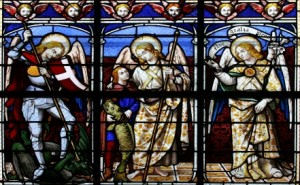
Michaelmas, also known as the Feast of the Archangels, is a religious holiday in the Christian faith that takes place on September 29th. Those seeking to be a minister should note that since it lies close to the autumnal equinox, Michaelmas is often thought of as the Catholic or Christian version of Mabon, the equinox celebration which was formerly exclusive to pagans, or non-Christian religions. In the Christian tradition, this holiday marks the defeat of Lucifer by the archangel Michael. The Universal Life Church respects and recognizes both of these traditions.
In European traditions, Feast of the Archangels eventually became an administrative holiday, when local officials of smaller municipalities would be called upon to hold elections and settle accounts. This tradition bled into the academic world, where “Michaelmas term” is used to refer to the fall school term. In the U.S. Supreme Court, new terms are convened on the first Monday of October, which is probably also a holdover from the British governmental observance of Michaelmas.
In truth, the Christian Bible only explicitly mentions Michael as being an actual archangel. Various Abrahamic religious traditions have identified several angels as having the rank of “archangel,” although there are a few holdouts who insist on strict interpretation of the term, perhaps most notably the Jehova’s Witnesses (a Christian denomination), who maintain that Michael is the only true “archangel.” The Roman Catholics, on the other hand, explicitly identify three angels as archangels (and, furthermore, as saints): St. Michael, St. Gabriel, and St. Raphael. This seemingly minor difference of opinion between various denominations is likely responsible for the different names ascribed to the holiday.
Feast of the Archangels celebrates the time when the archangel Michael is said to have driven Lucifer from Heaven, casting him down to the Earth. This is a significant event in the Bible, and is an allegorical key-frame for Christianity as a whole, since it signifies the triumph of God, light, and the forces of good over Lucifer, darkness, and the forces of evil.
For pagans, Mabon represents an opportunity to give thanks for the benefits of the harvest season; the fruits that come from the light and warmth of summer, which carry the people through winter’s darkness. In this way, the two holidays are similar, both evoking ideas of the triumph of light, warmth, and life over darkness, cold, and death. To be a minister who wishes to hold an interfaith service addressing both of these ideas, it’s important to understand how the Universal Life Church is able to integrate these two concepts into an interfaith tradition which gives respect and recognition to both traditions. Interfaith ministers can find the commonalities of different faiths and encourage harmony.

